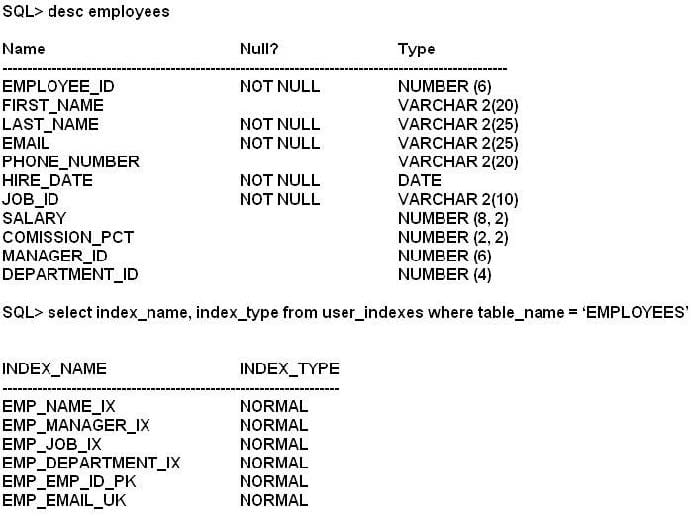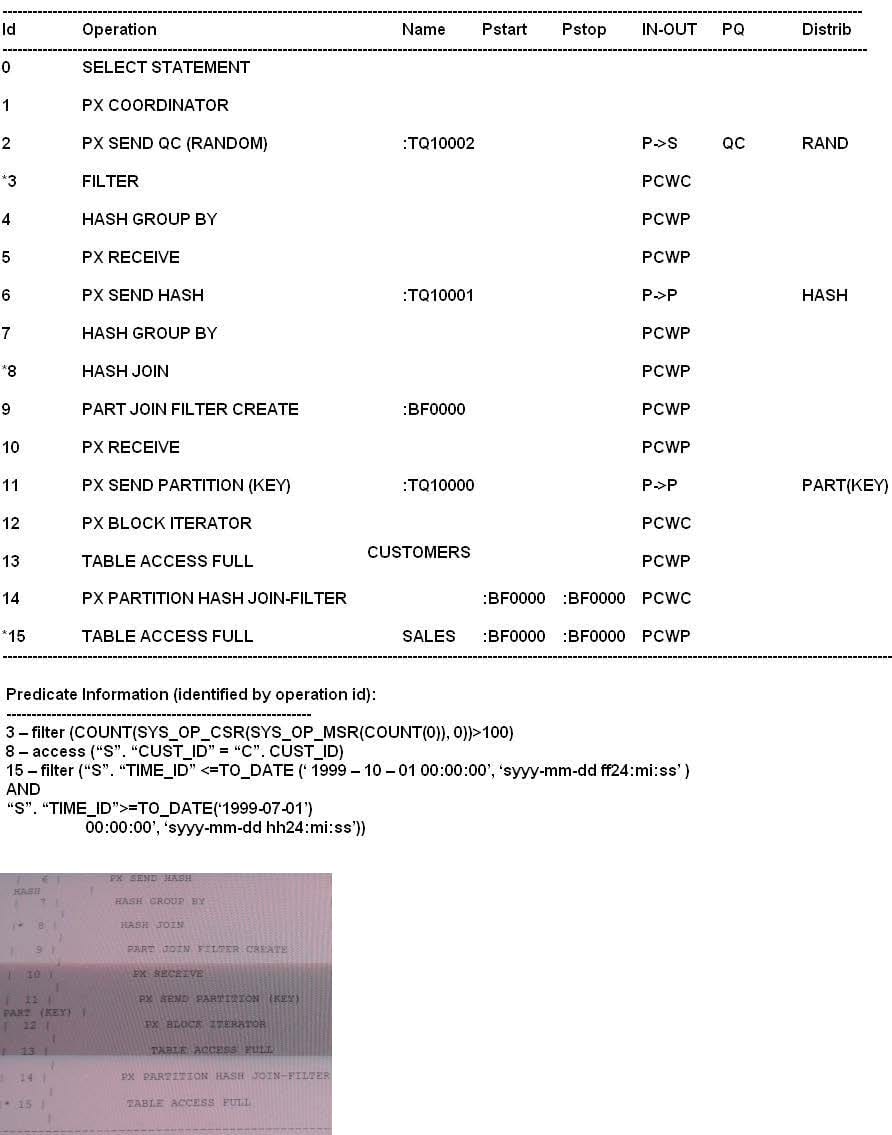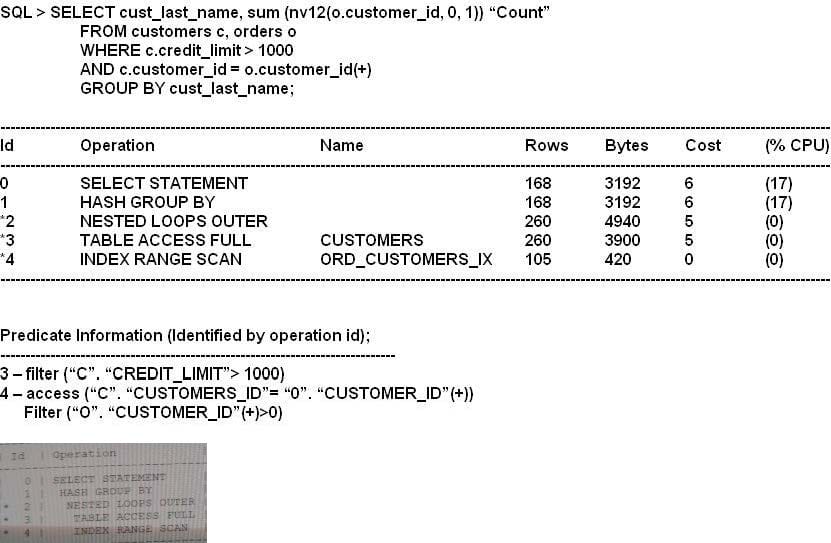Exam Details
Exam Code
:1Z0-117Exam Name
:Oracle Database 11g Release 2: SQL Tuning ExamCertification
:Oracle CertificationsVendor
:OracleTotal Questions
:125 Q&AsLast Updated
:Jun 29, 2025
Oracle Oracle Certifications 1Z0-117 Questions & Answers
-
Question 31:
Your database has the OLTP_SRV service configured for an OLTP application running on a middle tier. This service is used to connect to the database by using
connection pools. The application has three modules. You enabled tracing at the service by executing the following command:
SQL exec DBMS_MONITOR.SERV_MOD_ACT_TRACE_ENABLE (`OLTP_SRV');
What is the correct method of consolidating the trace files generated by the procedure?
A. Use all trace files as input for the tkprof utility to consolidate the trace files for a module.
B. Use one trace file at a time as input for the trcess utility and use tkprof utility to consolidate all the output files for a module.
C. Use the trcess utility to consolidate all trace files into a single output file, which can then be processed by the tkprof utility.
D. Use the tkprof utility to consolidate the trace files and create an output that can directly be used for diagnostic purposes.
-
Question 32:
You are administering a database supporting a DDS workload in which some tables are updated frequently but not queried often. You have SQL plan baseline for these tables and you do not want the automatic maintenance task to gather statistics for these tables regularly.
Which task would you perform to achieve this?
A. Set the INCREMENTAL statistic preference FALSE for these tables.
B. Set the STALE_PERCENT static preference to a higher value for these tables.
C. Set the GRANULARITY statistic preference to AUTO for these tables.
D. Set the PUBLISH statistic preference to TRUE for these tables.
-
Question 33:
Examine the Exhibit1 to view the structure of an indexes for the EMPLOYEES table.

Examine the query:
SQL> SELECT * FROM employees WHERE employees_id IN (7876, 7900, 7902);
EMPLOYEE_ID is a primary key in the EMPLOYEES table that has 50000 rows.
Which statement is true regarding the execution of the query?
A. The query uses an index skip scan on the EMP_EMP_ID_PK index to fetch the rows.
B. The query uses the INLIST ITERATOR operator to iterate over the enumerated value list, and values are evaluated using an index range scan on the EMP_EMP_ID_PK index.
C. The query uses the INLIST ITERATOR operator to iterate over the enumerated value list, and values are evaluated using a fast full index scan on the EMP_EMP_ID_PK index.
D. The query uses the INLIST ITERATOR operator to iterate over the enumerated value list, and values are evaluated using an index unique scan on the EMP_EMP_ID_PK index.
E. The query uses a fast full index scan on the EMP_EMP_ID_PK index fetch the rows.
-
Question 34:
Examine the execution plan:

Which two are true regarding the execution plan?
A. The CUSTOMERS table is hash partitioned.
B. The SALES table is hash partitioned.
C. The CUSTOMERS table is scanned first and selected partitions from the SALES table are scanned based on the BLOOM Filter created during the scan of the CUSTOMERS table.
D. The SALES table is scanned first and selected partitions from the CUSTOMERS table are scanned based on the Bloom Filter created during the scan of the SALES table.
E. Both the CUSTOMERS and SALES tables are scanned simultaneously and rows from the CUSTOMERS table are joined to row of the SALES table.
F. The CUSTOMERS table is range partitioned.
-
Question 35:
Which two tasks are performed during the optimization stage of a SQL statement?
A. Evaluating the expressions and conditions in the query
B. Checking the syntax and analyzing the semantics of the statement
C. Separating the clauses of the SQL statement into structures that can be processed
D. Inspecting the integrity constraints and optimizing the query based on this metadata
E. Gathering the statistics before creating the execution plan for the statement
-
Question 36:
An application frequently executed similar types of queries that vary only in the usage of literals in the WHERE clause. You plan to use bind variable in place of literal values.
The CURSOR_SHARING parameter to set to EXACT.
Which two statements are true about the usage of bind variables?
A. The number of latch gets in the library cache will be reduced.
B. Bind peeking will take place and subsequent execution of queries can have different plans based on the cardinality of the bind value in the column.
C. Bind peeking will take place and subsequent execution of queries can have different plans only when the histograms exists on a column used in WHERE clause.
D. Bind peeking will not happen and the optimizer will use the same plan for all bind values if no histograms exist on a column use in the WHERE clause.
E. Bind peeking will happen and subsequent execution of queries will have the same parent cursor but different child cursors.
-
Question 37:
Examine the query and its execution plan: Which two statements are true regarding the execution plan?

A. For every row of CUSTOMERS table, the row matching the join predicate from the ORDERS table are returned.
B. An outer join returns NULL for the ORDERS table columns along with the CUSTOMERS table rows when it does not find any corresponding rows in the ORDER table.
C. The data is aggregated from the ORDERS table before joining to CUSTOMERS.
D. The NESTED LOOP OUTER join is performed because the OPTIMZER_MODE parameter is set to ALL_ROWS.
-
Question 38:
In which three situations must you collect optimizer statistics manually for database objects in addition to automatic statistics collection?
A. When substantial DML activity occurs between the nightly automatic stats gathering maintenance job
B. When substantial activity occurs on a partition of the partitioned table.
C. When a table is used for bulk loads that add 10% or more to the total size of the table
D. When an index is created or dropped for a column
E. When the degree of parallelism is explicitly defined for a table
-
Question 39:
A database instance is configured in the shared server mode and it supports multiple applications running on a middle tier. These applications connect to the database using different services. You enabled the statistics gathering for the service by using the following command:
SQL > EXECUTE DBMS_MONITOR.SERV_MOD_ACT_STAT_ENABLE (`APPS1', NULL, NULL);
Which two statements are true regarding statistics gathered for APPS1 service?
A. The statistics are gathered for all the modules and actions within the service.
B. The statistics are collected at the session level for all sessions connected using the service.
C. The statistics are aggregated and stored in the V$SERV_MOD_ACT_STATS view.
D. The statistics are gathered for all the modules using the service only when DBMS_APPLICATION_INFO.SET_MODULE is executed to register with the service.
E. Statistics gathering is enabled only for the subsequent sessions using the service.
F. The statistics are gathered for all the applications using the service only when DBMS_APPLICATION_INFO.SET_ACTION is executed to register with the service.
-
Question 40:
You need to migrate database from oracle Database 10g to 11g. You want the SQL workload to start the 10g plans in the 11g database instance and evolve better plans.
Examine the following steps:
1.
Capture the pre-Oracle Database 11g plans in a SQL Tuning Set (STS)
2.
Export the STS from the 10g system.
3.
Import the STS into Oracle Database 11g.
4.
Set the OPTIMIZER_FEATURES_ENABLE parameter to 10.2.0.
5.
Run SQL Performance Analyzer for the STS.
6.
Set the OPTIMIZER_FEATURES_ENABLE parameter to 11.2.0.
7.
Rerun the SQL Performance Analyzer for the STS.
8.
Set OPTIMIZER_CAPTURE_SQL_PLAN_BASELINE to TRUE.
9.
Use DBMS_SPM.EVOLVE_SQL_BASELINE function to evolve the plans.
10.
Set the OPTIMIZER_USE_SQL_PLAN_BASELINE to TRUE.
Identify the required steps in the correct order.
A. 1, 2, 3, 4, 5, 6, 7,
B. 4, 8, 10
C. 1, 2, 3, 4, 8, 10
D. 1, 2, 3, 6, 9, 5
E. 1, 2, 3, 5, 9, 10
Related Exams:
1Z0-020
Oracle8i: New Features for Administrators1Z0-023
Architecture and Administration1Z0-024
Performance Tuning1Z0-025
Backup and Recovery1Z0-026
Network Administration1Z0-034
Upgrade Oracle9i/10g OCA to Oracle Database OCP1Z0-036
Managing Oracle9i on Linux1Z0-041
Oracle Database 10g: DBA Assessment1Z0-052
Oracle Database 11g: Administration Workshop I1Z0-053
Oracle Database 11g: Administration II
Tips on How to Prepare for the Exams
Nowadays, the certification exams become more and more important and required by more and more enterprises when applying for a job. But how to prepare for the exam effectively? How to prepare for the exam in a short time with less efforts? How to get a ideal result and how to find the most reliable resources? Here on Vcedump.com, you will find all the answers. Vcedump.com provide not only Oracle exam questions, answers and explanations but also complete assistance on your exam preparation and certification application. If you are confused on your 1Z0-117 exam preparations and Oracle certification application, do not hesitate to visit our Vcedump.com to find your solutions here.